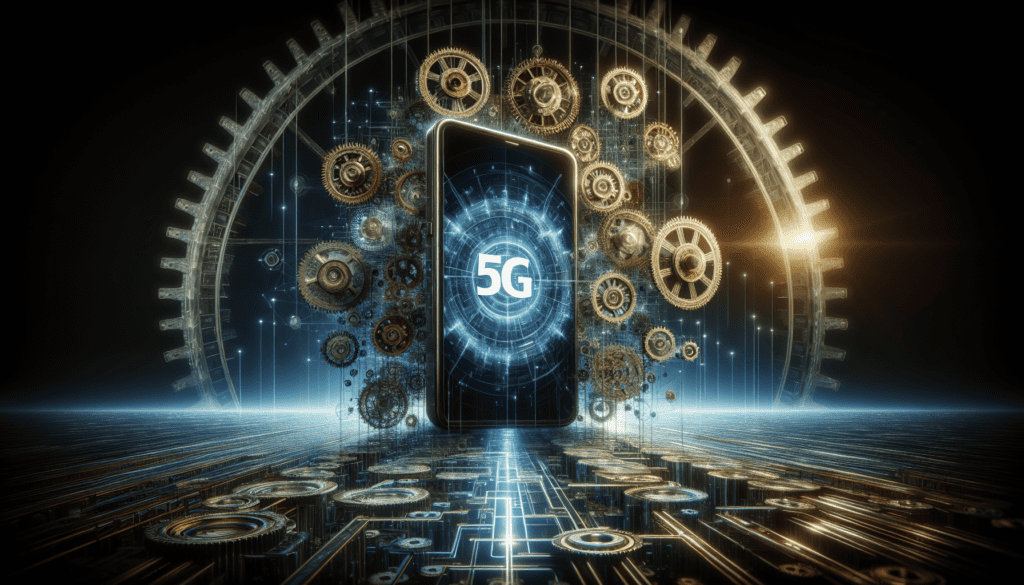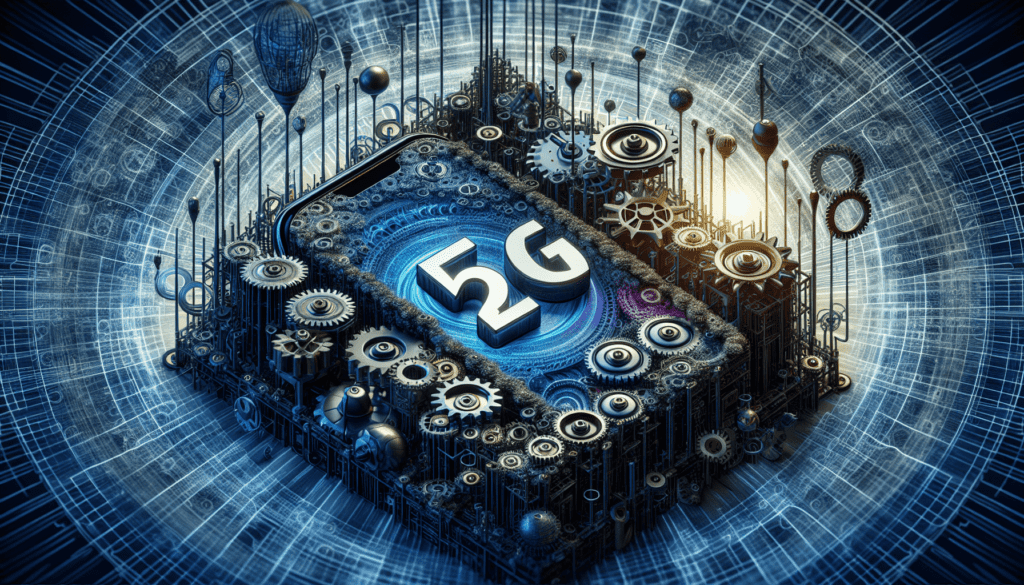Imagine a world where you can download movies in a matter of seconds, video chat with crystal-clear quality, and navigate the internet at lightning-fast speeds, all from the palm of your hand. Well, with the introduction of 5G technology, that world is becoming a reality. The impact of 5G on mobile device capabilities is nothing short of revolutionary, promising to transform the way we interact with our smartphones and tablets. In this article, we will explore the incredible possibilities that 5G brings to our mobile devices and how it will enhance our daily lives in ways we never thought possible.
Faster Internet Speeds
Improved download and upload speeds
With the implementation of 5G technology, mobile devices are set to experience significantly improved download and upload speeds. This means that you can download and upload files, videos, and images at a much faster rate compared to what you are accustomed to with the current generation of mobile networks. Imagine being able to download your favorite movies or streaming music albums in seconds rather than minutes or even hours. The speed and efficiency provided by 5G will transform the way you use your mobile device for downloading and uploading content.
Reduced latency
Latency refers to the time it takes for data to travel from one point to another, or the delay in the transfer of information. With 5G technology, latency will be significantly reduced compared to previous mobile network generations. This means that when you send a request or perform an action on your mobile device, such as clicking a link or opening an app, the response time will be almost instantaneous. You can expect a more seamless and smooth user experience, with minimal delays and lag in loading web pages, apps, and streaming content.
Enhanced streaming and gaming experiences
Streaming movies, TV shows, and music, as well as playing online games, will be transformed with the advent of 5G. The improved network speeds and reduced latency will result in a much smoother streaming experience, with high-quality video and audio playback. You won’t have to worry about buffering or interruptions during your favorite shows or games. Additionally, the low latency provided by 5G will enhance the responsiveness of online gaming, allowing for more precise and accurate gameplay. The immersive experience of virtual reality (VR) and augmented reality (AR) applications will also be greatly enhanced, with high-resolution graphics and real-time interactions. 5G is set to revolutionize the way we consume entertainment and engage in gaming on our mobile devices.
Increased Capacity and Network Efficiency
Ability to connect multiple devices without congestion
One of the biggest advantages of 5G is its ability to handle a significantly larger number of connected devices compared to previous mobile network generations. With the increasing dependence on smartphones, tablets, smartwatches, and other smart devices, the demand for network capacity has skyrocketed. 5G networks are designed to efficiently allocate resources and handle a large number of devices simultaneously. This means that even in crowded places, such as stadiums or busy city centers, you can connect multiple devices to the network without experiencing congestion or degraded performance. Whether you are at a concert or a conference, you can rest assured that your mobile devices will stay connected and deliver a seamless user experience.
Better network reliability and stability
5G networks offer improved reliability and stability compared to their predecessors. You will experience fewer dropped calls and interruptions in your mobile data connection. This is particularly important in situations where a stable and reliable connection is crucial, such as during important business calls or emergency situations. With 5G, you can rely on your mobile device to provide a consistent and dependable network connection, allowing you to stay connected and productive wherever you are.
Improved network capacity for crowded areas
In densely populated areas where network congestion is a common issue, 5G will bring about a significant improvement in network capacity. The increased capacity of 5G networks ensures that even in highly crowded areas, such as busy urban streets or crowded public transportation, you can continue to enjoy fast and reliable connectivity. This is especially beneficial for businesses and organizations that rely on the mobile network for their operations, as it allows employees and customers to stay connected and access critical services without any disruptions.

Enhanced Mobile Broadband
Ultra-High Definition (UHD) video streaming
5G will revolutionize the way we consume video content on our mobile devices. With its ultra-high-speed capabilities, 5G enables seamless streaming of ultra-high definition (UHD) videos. Whether you are watching your favorite movies, TV shows, or online videos, you can expect a crystal-clear visual experience with vibrant colors and stunning clarity. The enhanced mobile broadband provided by 5G allows you to enjoy UHD content, bringing the cinematic experience to the palm of your hand.
Seamless video conferencing and collaboration
In today’s interconnected world, video conferencing and virtual collaboration have become indispensable tools for businesses and individuals alike. With 5G, the quality and reliability of video conferencing and collaboration applications will be greatly enhanced. You can conduct virtual meetings and collaborate with colleagues or clients without any buffering, freezing, or lag. The seamless video conferencing experience offered by 5G will enable remote teams to work together effectively and foster greater productivity and efficiency.
Efficient use of cloud services and storage
Cloud services and storage have become fundamental aspects of our digital lives, allowing us to store and access files, photos, and documents from anywhere and on any device. With 5G, the efficiency of accessing cloud services and storage from your mobile device will be greatly improved. You will experience faster uploads and downloads, seamless synchronization of files, and an overall enhanced experience when utilizing cloud-based apps and services. This opens up new possibilities for mobile productivity and collaboration, as you can effortlessly access and save files on the cloud without any performance bottlenecks.
Internet of Things (IoT) Applications
Integration of smart devices and sensors into everyday life
The Internet of Things (IoT) has the potential to revolutionize the way we live and interact with our surroundings. 5G will play a crucial role in enabling seamless integration of smart devices and sensors into our everyday lives. From smart homes to smart cities, 5G will provide the necessary infrastructure to connect and control a wide range of IoT devices, such as smart appliances, wearable devices, and environmental sensors. This will bring about unprecedented convenience, security, and efficiency in our day-to-day activities.
Optimized automation and remote control capabilities
With the high-speed and low-latency capabilities of 5G, automation and remote control capabilities will be greatly optimized. You can remotely control and monitor your smart devices, such as thermostats, security cameras, and door locks, from anywhere in the world, with minimal delay and near real-time response. This opens up possibilities for energy savings, increased security, and enhanced convenience in managing your connected devices. From turning on the lights before you arrive home to monitoring your home’s security while you are away, 5G will transform the way you interact with your smart devices.
Real-time data processing and analytics
The massive amount of data generated by IoT devices requires fast and efficient processing. 5G networks, with their high-speed capabilities, will enable real-time data processing and analytics at the edge of the network. This means that data can be processed and analyzed immediately, without the need for it to be transmitted to a remote server for processing. Real-time data processing and analytics enable fast and accurate decision-making, enabling businesses and organizations to derive valuable insights and take immediate action based on the data collected from IoT devices.

Advances in Augmented Reality (AR) and Virtual Reality (VR)
Realistic and immersive AR/VR experiences
Augmented Reality (AR) and Virtual Reality (VR) have already begun to revolutionize various industries, from gaming and entertainment to healthcare and education. With 5G, AR and VR experiences will be taken to the next level. The high-speed and low-latency capabilities of 5G networks will allow for more realistic and immersive AR/VR experiences. You can expect highly detailed and interactive virtual worlds, whether you are exploring new cities through AR travel guides or immersing yourself in virtual gaming environments. 5G will push the boundaries of what is possible with AR and VR, delivering unparalleled experiences on your mobile device.
Support for complex and high-resolution graphics
The high-speed capabilities of 5G networks enable support for complex and high-resolution graphics in AR and VR applications. Whether you are playing graphic-intensive games or exploring 3D models in an educational application, 5G ensures that you can enjoy stunning visuals and lifelike graphics on your mobile device. The improved network speeds and reduced latency of 5G networks ensure smooth rendering and seamless interactions in intricate virtual environments.
Low latency for seamless user interactions
One of the key challenges in AR and VR applications is achieving low latency to ensure smooth and natural user interactions. With the ultra-low latency of 5G, users will experience near real-time feedback and responses in AR and VR environments. This means that when you interact with objects or navigate through virtual spaces, the response time will be virtually instantaneous. This enhances the overall immersive experience and removes any sense of disconnection or delay between your actions and the resulting feedback in AR and VR applications.
Development of Autonomous Vehicles
Enhanced vehicle-to-vehicle (V2V) and vehicle-to-infrastructure (V2I) communication
The development of autonomous vehicles is heavily reliant on reliable and high-speed communication networks. 5G is set to play a pivotal role in enabling the seamless communication between autonomous vehicles and their surroundings. Vehicle-to-Vehicle (V2V) and Vehicle-to-Infrastructure (V2I) communication, facilitated by 5G, will enable autonomous vehicles to exchange vital information, such as location, speed, and road conditions, in real-time. This will enhance the safety and efficiency of autonomous vehicles, enabling them to react quickly to changing situations and navigate through complex traffic scenarios.
Improved safety and traffic management systems
With 5G networks, autonomous vehicles will have access to real-time information about road conditions, traffic patterns, and potential hazards. This information can be shared among vehicles and with traffic management systems, allowing for more efficient traffic flow and improved safety. The reduced latency provided by 5G ensures that decisions can be made and communicated in real-time, minimizing the risk of accidents and optimizing traffic management strategies. 5G will revolutionize the way we travel by enabling a safer and more efficient transportation system.
Efficient data exchange for real-time navigation
With 5G, real-time navigation systems in autonomous vehicles will be significantly enhanced. Autonomous vehicles will have access to up-to-date and accurate maps, traffic information, and navigation instructions, allowing for seamless and precise navigation. The fast and reliable data exchange facilitated by 5G ensures that autonomous vehicles can make informed decisions and adapt their routes in real-time, based on the latest information. This will result in more efficient and reliable navigation, reducing travel times and improving the overall passenger experience.
Expansion of Remote Work and Telemedicine
Seamless video conferencing and virtual collaboration
The COVID-19 pandemic has accelerated the adoption of remote work and virtual collaboration, and 5G will further amplify the capabilities of these practices. With 5G, the quality and reliability of video conferencing and virtual collaboration tools will be significantly improved. You will be able to have high-definition video conferences with colleagues or clients without any disruptions or buffering. Remote teams can collaborate seamlessly, sharing screens, files, and ideas in real-time. The enhanced connectivity provided by 5G ensures that remote work becomes even more productive and efficient, regardless of your location.
Remote access to medical services and teleconsultations
Telemedicine has emerged as a valuable healthcare solution, enabling people to access medical services remotely. With 5G, telemedicine capabilities will be greatly enhanced. You can consult with doctors and healthcare professionals through secure video calls, share medical records and diagnostic images in real-time, and receive remote medical advice and prescriptions. The high-speed and low-latency capabilities of 5G ensure that remote consultations are as close to in-person visits as possible, enabling timely healthcare services even in remote or underserved areas.
Enhanced connectivity for remote learning and education
The education sector has also witnessed a significant shift towards remote learning and online education platforms. 5G will provide a significant boost to remote learning capabilities by offering enhanced connectivity and improved user experiences. You can attend virtual classrooms, participate in interactive online lectures, and collaborate with classmates seamlessly. The high-speed capabilities of 5G enable the efficient delivery of educational content, ensuring that online lessons and multimedia materials load quickly and without interruptions. 5G will empower students and educators alike to embrace remote learning and unlock new possibilities for education.
Edge Computing and Cloud Integration
Faster data processing and reduced latency at the network edge
Edge computing is a paradigm that brings data processing and storage closer to the source of data generation. 5G networks enable faster data processing and reduced latency at the network edge, which means that the processing of data can occur in proximity to the devices generating the data. This has numerous benefits, such as reduced network congestion, improved response times, and enhanced privacy and security. With 5G and edge computing, applications and services that require real-time data processing, such as autonomous vehicles, augmented reality, and industrial automation, can operate efficiently and deliver a seamless user experience.
Efficient utilization of cloud resources for storage and computation
Cloud computing has revolutionized the way we store and process data. With the integration of 5G and cloud services, the capabilities of mobile devices will be further enhanced. 5G enables efficient utilization of cloud resources for storage and computation, allowing mobile devices to offload resource-intensive tasks to the cloud. This reduces the burden on the mobile device’s hardware and extends its capabilities, enabling powerful applications and services that were previously only possible on high-end desktop computers. With 5G and cloud integration, you can experience the power of cloud computing on your mobile device, whether it’s running complex algorithms, rendering high-resolution graphics, or accessing large datasets.
Improved scalability and reliability of cloud-based applications
Cloud-based applications and services have become an integral part of our daily lives. 5G will greatly improve the scalability and reliability of these cloud-based applications. With the high-speed and low-latency capabilities of 5G networks, cloud-based applications can be accessed and utilized with minimal delay and interruptions. Whether you are using productivity tools, streaming media, or playing online games, you can expect a seamless and uninterrupted experience. The improved scalability and reliability of cloud-based applications ensure that you can rely on these services for your personal and professional needs, regardless of the size and complexity of the application or the number of users accessing it.
Advancements in Artificial Intelligence (AI) and Machine Learning (ML)
Real-time processing of large datasets for AI applications
Artificial Intelligence (AI) and Machine Learning (ML) have become key technologies driving innovation across various industries. 5G will enable real-time processing of large datasets required for AI and ML applications. This means that AI algorithms can analyze and make predictions on vast amounts of data without significant delays. Real-time processing allows for immediate decision-making and near-instantaneous insights, paving the way for advanced AI-powered applications on mobile devices. From personalized recommendations to intelligent virtual assistants, 5G will enable a new era of smart AI applications on your mobile device.
Enhanced capabilities in image and speech recognition
Image and speech recognition are critical components of many AI applications, such as facial recognition, voice assistants, and augmented reality. With 5G, the capabilities of image and speech recognition algorithms will be greatly enhanced. The high-speed and low-latency capabilities of 5G enable faster and more accurate analysis of visual and auditory data. This translates to improved image recognition in photography apps, more accurate transcription and voice commands in voice assistants, and seamless integration of AR experiences with the real world. 5G will take image and speech recognition to new levels of performance and usability on mobile devices.
Optimized AI algorithms and model training
Training AI models and algorithms usually requires significant computational resources and time. 5G, with its integration of edge computing and cloud services, will optimize the process of AI model training and algorithm development on mobile devices. The high-speed connectivity and access to cloud resources provided by 5G enable efficient data processing and training of AI models, reducing the time and resources required for model development. This opens up opportunities for developers and researchers to deploy and experiment with AI applications on a wider range of mobile devices, leading to accelerated innovation and advancements in the field of AI and ML.
Impact on Battery Life and Device Design
Advanced power management for better battery efficiency
Battery life is a crucial aspect of mobile device performance. With 5G, advancements in power management techniques and technologies will significantly improve battery efficiency. 5G networks are designed to minimize power consumption during data transmission and reception, allowing your device to conserve energy and prolong battery life. This means that you can use your mobile device for longer periods without having to worry about running out of battery power, even when utilizing resource-intensive applications or streaming high-definition content.
Opportunity for sleeker and more lightweight mobile devices
The integration of 5G technology presents an opportunity for sleeker and more lightweight mobile device designs. With the improved network efficiency and reduced space requirements of 5G components, device manufacturers can allocate more space and resources for other components and features. This opens up possibilities for thinner and lighter mobile devices, providing a more comfortable and portable user experience. Whether it’s a smartphone, tablet, or wearable device, 5G technology will enable device manufacturers to push the boundaries of design and deliver more aesthetically pleasing and ergonomic mobile devices.
Reduced energy consumption for prolonged device usage
Energy consumption is a critical consideration for mobile device users. With 5G’s optimized power management techniques and improved network efficiency, mobile devices will consume less energy during data transmission and reception. This translates to reduced energy consumption, allowing you to use your device for longer periods without having to recharge frequently. Whether you are traveling, working, or simply enjoying your mobile device, 5G enables prolonged usage without compromising on performance or user experience. The reduced energy consumption offered by 5G contributes to a more sustainable and eco-friendly mobile device ecosystem.
In conclusion, the impact of 5G on mobile device capabilities is immense and far-reaching. From faster internet speeds to enhanced connectivity, improved quality of services to optimized power management, 5G technology is set to revolutionize the way we use our mobile devices. The comprehensive benefits of 5G, ranging from faster download and upload speeds to advanced AI and IoT applications, open up new possibilities for entertainment, productivity, healthcare, transportation, and education. With 5G, be ready to experience a new era of connectivity and mobile device capabilities that will transform the way you live, work, and interact with the world around you.





